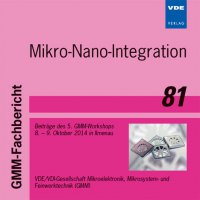Localized Collection of Airborne Analytes: A Transport Driven Approach to Improve the Response Time of Existing Gas Sensor Designs including SERS based Detection of Small Molecules
Konferenz: Mikro-Nano-Integration - Beiträge des 5. GMM-Workshops
08.10.2014 - 09.10.2014 in Ilmenau, Deutschland
Tagungsband: Mikro-Nano-Integration
Seiten: 4Sprache: EnglischTyp: PDF
Persönliche VDE-Mitglieder erhalten auf diesen Artikel 10% Rabatt
Autoren:
Fang, Jun; Park, Se-Chul (Electrical and Computer Engineering, University of Minnesota, 200 Union St. SE, Minneapolis, MN 55455, USA)
Schlag, Leslie; Stauden, Thomas; Pezoldt, Jörg; Jacobs, Heiko O. (Technische Universität Ilmenau, Fachgebiet Nanotechnologie, Gustav-Kirchhoff-Str. 1, 98693 Ilmenau, Germany)
Inhalt:
The detection of single binding has been a recent trend in sensor research introducing various sensor designs where the active sensing elements are nanoscopic in size. Currently, transport and collection of airborne analytes for gas sensors is either diffusion based or non-localized and it becomes increasingly unlikely for analytes to interact with sensing structures where the active area is shrunk, trading an increased sensitivity with a slow response time. This report introduces a corona discharge based analyte charging method and an electrodynamic nanolens based analyte concentration concept to effectively transport airborne analytes to sensing points to improve the response time of existing gas sensor designs. We demonstrate localized collection of analytes over a wide range, including microscopic particles, nanoparticles, and small molecules. In all cases we find that the collection rate is several orders of magnitudes higher than in the case where the collection is driven by diffusion. The collection scheme is integrated on an existing SERS (surface-enhanced Raman spectroscopy) based sensor. In terms of response time, the process is able to detect analytes at 9 ppm (parts per million) within 1 second. As a comparison, 1 hour is required to reach the same signal level when diffusion-onlytransport is used.


